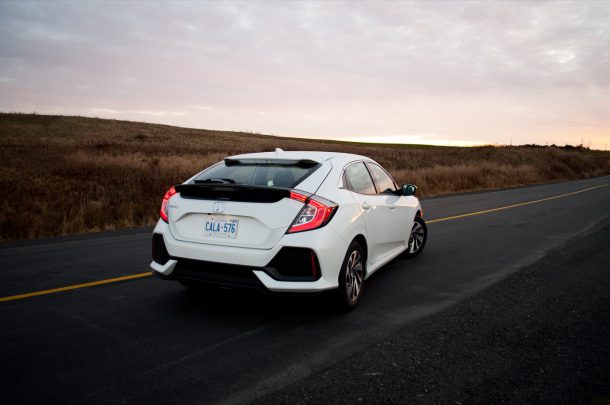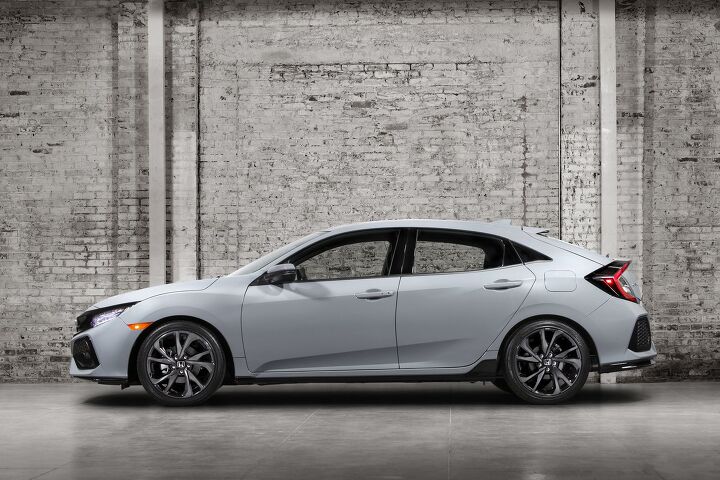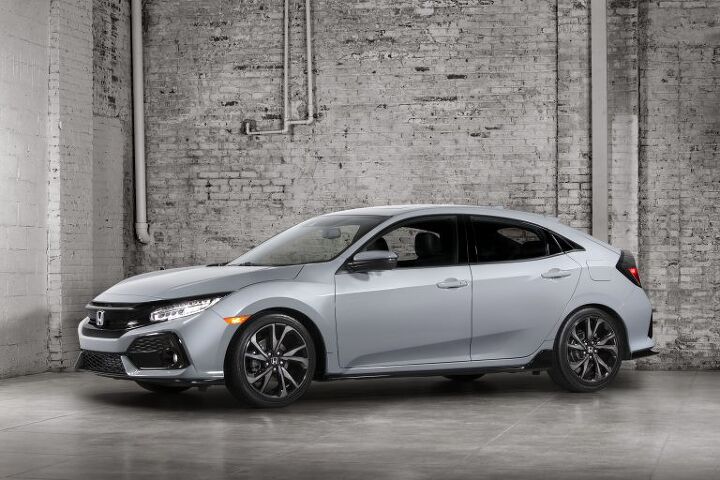#2017HondaCivicHatchback
Comparison Test: 2017 Honda Civic Hatchback Vs. 2017 Mazda 3 5-Door - Grins Matter
Until recently, American car shoppers generally treated hatchbacks with a level of disdain normally reserved for that fetid cheese you forgot about in the back of the fridge.
It made sense; most of them were base-model penalty boxes with all the charm of plain oatmeal. Now, though, the market is awash with five-doors featuring content levels and power outputs formerly reserved for much more expensive machinery.
Honda recently re-entered the hatchback game with its 2017 Civic, while Mazda has been hawking a five-door 3 since its introduction a dozen years ago. Last week, the stars aligned and the press-fleet gods shone upon TTAC by placing a Honda Civic Hatchback and Mazda 3 5-Door in the grubby hands of Tim and Matt during the same week.
While the two cars were optioned differently (a CVT-equipped Civic LX and a manual-equipped Mazda 3 5-Door Grand Touring), we nevertheless took the opportunity to get these two hatchbacks together and ask the question: “Which is gooder?”
The 2017 Honda Civic Hatchback Is The Ugliest Car I've Driven Since …
As I exited the grocery store this past Sunday night thronged by late night shoppers, the expressions on the faces of those who walked past the 2017 Honda Civic Hatchback LX, parked right in front of the store, were not difficult to discern.
Then, as it became obvious I was the “owner” of said Civic, previously repulsed glances shifted toward me, now full of pity. Can’t say I was surprised. The exterior design Honda foisted upon an otherwise excellent car is downright horrifying.
I wanted to shout across the grocery store parking lot, “It’s not mine.”
2017 Honda Civic Hatchback: Pricing, Power Announced for Compact Cavern on Wheels
Starting next Monday, North American shoppers will be able to stroll into Honda dealers across the nation and take delivery of a Civic Hatchback. Mercifully, it looks a lot better than the pug-nosed, bent-nail-shifter Si oddity of the early 2000s.
Forecast: American Honda Plans To Sell 40,000 Civic Hatchbacks Per Year
As 2017 Honda Civic Hatchbacks roll off ships on the Atlantic coast of North America, we’ve learned that Honda expects to send 40 percent of the company’s Swindon, England, Civic assembly plant output to North America.
In an article discussing the launch of the European-market Civic Hatchback at the upcoming Mondial de l’Automobile in Paris, Automotive News Europe says 20 percent of Civic Hatchback production will remain in the United Kingdom. Another 40 percent will head to the rest of Europe. ANE also says the United States “will take 40 percent of the 120,000-unit annual production, the company predicts.”
Long live the crossover? Honda’s about to put another 48,000 hatchbacks on North American roads.
American Honda Believes Civic Hatchback Will Not Cannibalize Civic Sedan Sales
Not since the sixth-generation Honda Civic of 1996-2000 has American Honda made a hatchback available as a conventional part of the Civic lineup.
Yes, there was the British-built Civic hatchback of 2002-2005, but it was an Si-only model with limited appeal and little connection to the broader Civic lineup.
The new 2017 Honda Civic Hatchback that’s now reaching North American shores — it’s built at the same Swindon, England, plant as the aforementioned Civic Si — is another thing altogether. It’s not merely a two-door hatchback entry into the Civic fold, as the Civic hatch so often was in the distant past. Nor is the new Civic Hatchback exclusively meant to be a performance-oriented hot hatch, though it will form the foundation of North America’s first-ever Civic Type R.
No, the new, turbo-only, four-door Civic Hatchback closely mirrors the upper-trim levels of the established tenth-generation Civic lineup. Presumably, then, the new Civic Hatchback, with all of its flexibility and practicality and tailgate possibilities, will steal sales from the regular Honda Civic sedan and coupe?
Honda says no.
2017 Honda Civic Hatchback Gets Official: All Turbos, Manual Availability, Type R Promised
American Honda has wisely revealed studio images and announced a level of detail regarding its 2017 Honda Civic Hatchback. After pictures ( from an unfortunate angle) of the new car’s early shipment filtered to America last week, the tenth-generation’s third body style looks significantly better in Honda’s official shots.
Honda’s 1.5-liter turbocharged four-cylinder engine will power all U.S.-bound Civic Hatchbacks across LX, Sport, EX, EX-L, and Sport Touring trims. The LX, Sport, and EX will be available with a six-speed manual transmission. Until now, the 1.5T upgrade in the tenth-gen Civic was linked exclusively to a continuously variable transmission.
Third Shoe Drops: Boatload of 2017 Honda Civic Hatchbacks Spied
The third addition to the Honda Civic lineup was recently spotted at a UK port, providing a glimpse of a vehicle we’ve only seen in prototype guise.
The Honda Civic hatchback shown at the Geneva Motor Show in March wasn’t a production model, but images posted on the CivicX forum show what American buyers can expect.






















Recent Comments